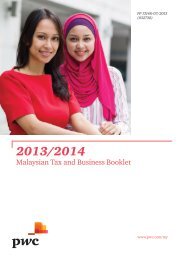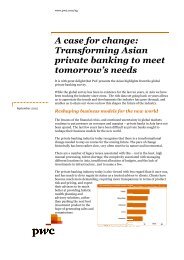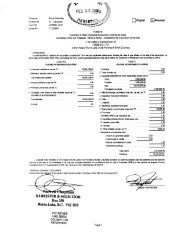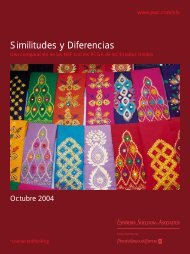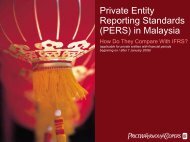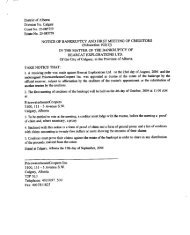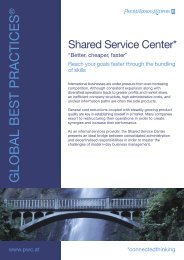TLS Newsletter 11 marzo 2011 - PwC
TLS Newsletter 11 marzo 2011 - PwC
TLS Newsletter 11 marzo 2011 - PwC
You also want an ePaper? Increase the reach of your titles
YUMPU automatically turns print PDFs into web optimized ePapers that Google loves.
Rimane dubbia l’applicabilità della norma alle stabili<br />
organizzazione italiane di banche estere: infatti, il dispositivo<br />
normativo prevede che (i) la perdita sia rilevata in<br />
un bilancio individuale, (ii) la trasformazione avviene<br />
al momento dell’approvazione da parte dell’assemblea<br />
dei soci e (iii) il rapporto di trasformazione abbia come<br />
denominatore il capitale sociale e le riserve. In effetti,<br />
queste condizioni non appaiono soddisfatte nel caso di<br />
stabile organizzazione italiana che non approvano alcun<br />
bilancio per l’attività svolta in Italia: tuttavia, l’eventuale<br />
esclusione comporterebbe un’indubbia discriminazione<br />
di questi soggetti nei confronti degli operatori italiani e<br />
rappresenterebbe una limitazione delle regole di libero<br />
stabilimento imposte dall’Unione Europea.<br />
Per quanto attiene l’ambito oggettivo, come già anticipato,<br />
la norma fa riferimento alle imposte anticipate iscritte<br />
in bilancio a fronte:<br />
(i) dell’importo delle svalutazioni dei crediti eccedenti<br />
i limiti fiscali annuali, oggi pari allo 0,3% dei crediti<br />
iscritti in bilancio, deducibile in quote costanti nei successivi<br />
diciotto anni. La voce ha assunto nei bilanci delle<br />
banche e degli enti finanziari un peso significativo anche<br />
alla luce delle ultime restrizioni dei limiti di deducibilità,<br />
rappresentando una particolarità della realtà fiscale<br />
italiana, molto discussa e criticata nel settore;<br />
(ii) di avviamenti e altre attività immateriali. Si dovrebbe<br />
fare riferimento principalmente a due fattispecie:<br />
imposte anticipate su svalutazioni relative ad attività<br />
fiscalmente riconosciute, non dedotte perché eccedenti<br />
i limiti consentiti (casistica minoritaria) oppure imposte<br />
anticipate iscritte a fronte di affrancamenti di avviamenti<br />
non fiscalmente riconosciuti.<br />
In questo secondo caso, ci si riferisce alle previsioni di<br />
cui all’articolo 15, comma 10 e <strong>11</strong>, D.L. n. 185/2008, che<br />
ha introdotto una disciplina speciale in tema di riallineamento<br />
dei valori in caso di operazioni straordinarie,<br />
consentendo di assoggettare ad imposta sostitutiva del<br />
16% i maggiori valori non fiscalmente rilevanti attribuiti<br />
all’avviamento, ai marchi ed alle altre attività immateriali.<br />
Il principale beneficio connesso all’applicazione di<br />
questa disciplina consiste nella possibilità di dedurre (a<br />
prescindere dalla previa imputazione al conto economico),<br />
l’ammortamento dei marchi e dell’avviamento<br />
in tempi più rapidi rispetto alle norme del TUIR: infatti,<br />
è consentita la deduzione dell’ammortamento di tali<br />
beni in misura pari ad un nono, anziché un diciottesimo,<br />
come ordinariamente previsto (in tal senso, come si<br />
vedrà nel prosieguo, a copertura finanziaria della norma<br />
si è stabilito un allungamento a dieci anni del periodo di<br />
ammortamento fiscale degli attivi affrancati). Il trattamento<br />
contabile, per i soggetti IAS/IFRS adopter, è stato<br />
espressamente regolato mediante il documento OIC n. 1<br />
del 2009, che prevede tre differenti modelli di contabilizzazione<br />
degli effetti scaturenti dalla decisione di affrancare<br />
l’avviamento.<br />
Applicability of the rule under the Italian permanent<br />
establishment of foreign banks is doubtful: in fact, the new<br />
provision states that (i) the loss has to be recorded in the<br />
individual financial statements, (ii) the conversion takes<br />
place upon the approval by the shareholders’ meeting and<br />
(iii) the denominator of the conversion ratio corresponds<br />
to the capital and reserves. In fact, these conditions do not<br />
appear to be met in the case of Italian permanent establishments<br />
as such entities do not approve any balance sheet<br />
for the activities carried out in Italy: however, the possible<br />
exclusion of these subjects would lead to a discrimination<br />
against Italian entities and represents a limitation of the<br />
establishment right set forth by the European Union.<br />
With regard to the scope of the provision, as previously<br />
stated, the law decree makes reference to deferred tax assets<br />
recognized in the financial statements in relation to:<br />
(i) write-downs of receivables exceeding the annual tax<br />
limits (now 0.3% of loans booked), deductible in equal<br />
installments over the next eighteen years. This type of<br />
deferred tax asset has gained significant importance on the<br />
balance sheets of banks and financial institutions in light<br />
of recent restrictions on the deductibility, representing a<br />
peculiarity of the Italian fiscal system;<br />
(ii) goodwill and other intangible assets. Reference should<br />
be made mainly to two situations: deferred tax assets<br />
posted as a consequence of write-downs of assets recognized<br />
for tax purposes, but not deducted for exceeding the allowed<br />
limits (minority cases) or deferred tax assets recognized<br />
in respect of realignment of goodwill not recognized for<br />
tax purposes.<br />
In the latter case, we refer to the provisions of article 15,<br />
paragraph 10 and <strong>11</strong>, Law Decree No 185/2008, which<br />
introduced a special framework in terms of realignment<br />
of values in case of business combinations, through the<br />
payment of a substitute tax equal to 16% of the higher<br />
values attributed to goodwill, trademarks and other intangible<br />
assets.<br />
The main benefit associated with the implementation of<br />
this provision is the ability to deduct the depreciation of<br />
trademarks and goodwill more quickly than the ordinary<br />
rules: in fact, the depreciation of such assets is allowed in<br />
an amount equal to one-ninth, rather than one-eighteenth,<br />
as normally expected.<br />
The accounting treatment of such realignment for IAS/<br />
IFRS adopters was expressly regulated by the OIC Document<br />
n. 1 of 2009, which provides three different accounting<br />
models.<br />
<strong>TLS</strong> <strong>Newsletter</strong> n° 3 Anno 20<strong>11</strong> 50




